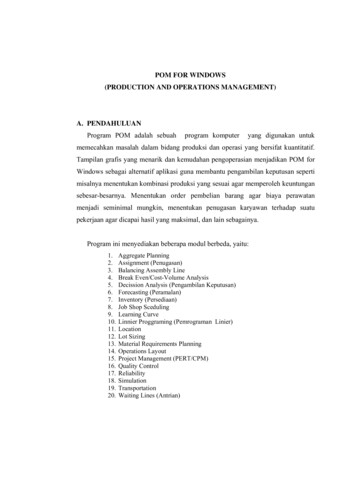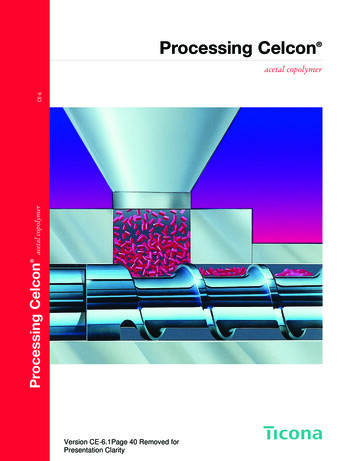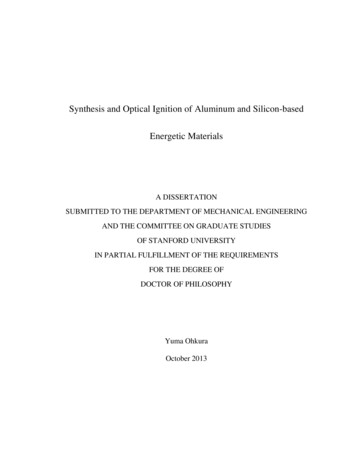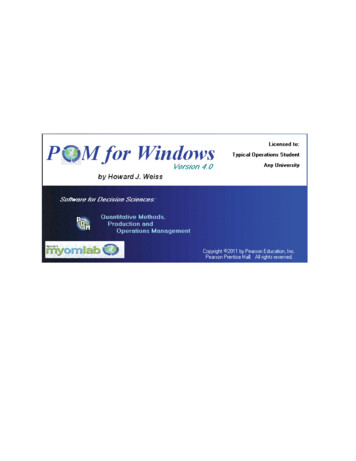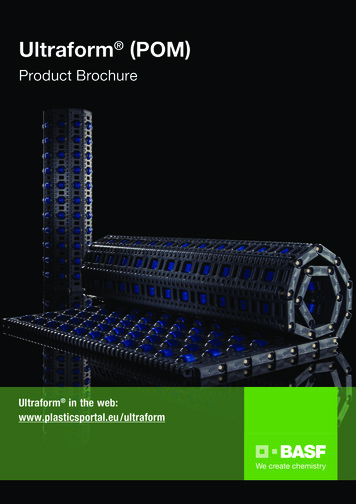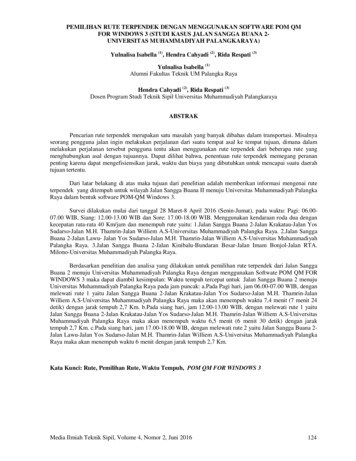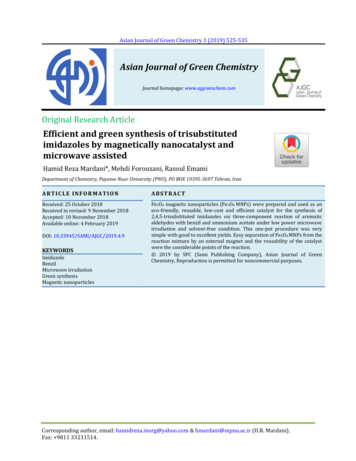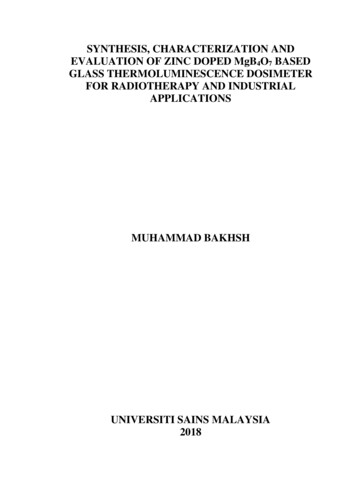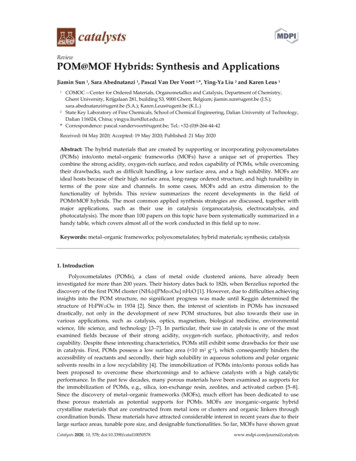
Transcription
ReviewPOM@MOF Hybrids: Synthesis and ApplicationsJiamin Sun 1, Sara Abednatanzi 1, Pascal Van Der Voort 1,*, Ying-Ya Liu 2 and Karen Leus 11COMOC—Center for Ordered Materials, Organometallics and Catalysis, Department of Chemistry,Ghent University, Krijgslaan 281, building S3, 9000 Ghent, Belgium; jiamin.sun@ugent.be (J.S.);sara.abednatanzi@ugent.be (S.A.); Karen.Leus@ugent.be (K.L.)2 State Key Laboratory of Fine Chemicals, School of Chemical Engineering, Dalian University of Technology,Dalian 116024, China; yingya.liu@dlut.edu.cn* Correspondence: pascal.vandervoort@ugent.be; Tel.: 32-(0)9-264-44-42Received: 04 May 2020; Accepted: 19 May 2020; Published: 21 May 2020Abstract: The hybrid materials that are created by supporting or incorporating polyoxometalates(POMs) into/onto metal–organic frameworks (MOFs) have a unique set of properties. Theycombine the strong acidity, oxygen-rich surface, and redox capability of POMs, while overcomingtheir drawbacks, such as difficult handling, a low surface area, and a high solubility. MOFs areideal hosts because of their high surface area, long-range ordered structure, and high tunability interms of the pore size and channels. In some cases, MOFs add an extra dimension to thefunctionality of hybrids. This review summarizes the recent developments in the field ofPOM@MOF hybrids. The most common applied synthesis strategies are discussed, together withmajor applications, such as their use in catalysis (organocatalysis, electrocatalysis, andphotocatalysis). The more than 100 papers on this topic have been systematically summarized in ahandy table, which covers almost all of the work conducted in this field up to now.Keywords: metal–organic frameworks; polyoxometalates; hybrid materials; synthesis; catalysis1. IntroductionPolyoxometalates (POMs), a class of metal oxide clustered anions, have already beeninvestigated for more than 200 years. Their history dates back to 1826, when Berzelius reported thediscovery of the first POM cluster (NH4)3[PMo12O40] nH2O [1]. However, due to difficulties achievinginsights into the POM structure, no significant progress was made until Keggin determined thestructure of H3PW12O40 in 1934 [2]. Since then, the interest of scientists in POMs has increaseddrastically, not only in the development of new POM structures, but also towards their use invarious applications, such as catalysis, optics, magnetism, biological medicine, environmentalscience, life science, and technology [3–7]. In particular, their use in catalysis is one of the mostexamined fields because of their strong acidity, oxygen-rich surface, photoactivity, and redoxcapability. Despite these interesting characteristics, POMs still exhibit some drawbacks for their usein catalysis. First, POMs possess a low surface area ( 10 m2 g 1), which consequently hinders theaccessibility of reactants and secondly, their high solubility in aqueous solutions and polar organicsolvents results in a low recyclability [4]. The immobilization of POMs into/onto porous solids hasbeen proposed to overcome these shortcomings and to achieve catalysts with a high catalyticperformance. In the past few decades, many porous materials have been examined as supports forthe immobilization of POMs, e.g., silica, ion-exchange resin, zeolites, and activated carbon [5–8].Since the discovery of metal–organic frameworks (MOFs), much effort has been dedicated to usethese porous materials as potential supports for POMs. MOFs are inorganic–organic hybridcrystalline materials that are constructed from metal ions or clusters and organic linkers throughcoordination bonds. These materials have attracted considerable interest in recent years due to theirlarge surface areas, tunable pore size, and designable functionalities. So far, MOFs have shown greatCatalysts 2020, 10, 578; lysts
Catalysts 2020, 10, 5782 of 33potential in gas storage and separation, catalysis, sensing, drug delivery, proton conductivity, solarcells, supercapacitors, and biomedicine [8–13]. Moreover, MOFs are regarded as an outstandingplatform for introducing guest molecules because of the high accessibility of their internal surfacearea and long-range ordered channels. So far, several active sites have been successfully embeddedin the pores or cages of MOFs, such as noble metals, metal oxides, enzymes, and POMs [14–17].The first report of a POM@MOF hybrid was reported in 2005 by Férey and co-workers [18]. Inthis seminal work, the POM, K7PW11O39 (van der Waals radius, 13.1 Å), was successfullyencapsulated into the big cages of the highly stable Cr-based MOF, MIL-101, by using animpregnation method. To date, several other thermal and chemical stable MOFs have been appliedas supports to host POMs for their use in catalysis, including MIL, UiO, ZIF series, NU-1000, andCu-BTC frameworks (see Table 1). The most examined POMs that have been encapsulated intoMOFs are the well-known Keggin [XM12O40]n and Dawson [X2M18O62]n (X Si, P, V, Bi, etc.; M V,Mo, W, etc.) POMs and their derivatives. These POMs are of significant interest because theirstructure and properties can be easily varied by removing one or more MO4 units, leading tolacunary POMs such as [PW9O34]9 , or by the substitution of X and M by different metals or acombination of two fragments of the Keggin structure, leading to sandwich-type POMs such as[Tb(PW11O39)2]11 .There are several advantages of using MOFs as a host matrix to encapsulate POMs. First of all,their exceptionally high surface areas and confined cages/channels make it possible to ensure ahomogeneous distribution of the POM in the MOF host. This not only prevents the agglomeration ofPOMs, but also improves their stability and recyclability and ensures a fast diffusion of substratesand products. Secondly, the highly regular cages and windows of MOFs ensure a high substrateselectivity, or, in other words, only specific substrates/products are able to reach the active POMsites. Thirdly, owing to the good interaction and electron transfer between the MOF and POM, anincreased synergistic catalytic performance is typically observed. Finally, the chemical environmentof POMs can easily be adjusted through modification or functionalization of MOFs. Therefore,POM@MOF hybrids not only combine the interesting properties of POMs and MOFs, but also allowthe aforementioned disadvantages of POMs to be tackled to afford synergistic catalysis. This reviewis focused on the synthetic aspects of POM@MOF hybrids, as well as their use in catalysis(organocatalysis, electrocatalysis, and photocatalysis). Alongside the POM@MOF systems discussedhere, where the POMs are encapsulated inside a MOF host, POM-based MOFs have also beeninvestigated. In these MOFs, the POMs form the actual metal nodes that are interconnected byorganic linkers [19–21]. However, these fall outside the scope of this review.Table 1. Physical properties of representative metal–organic frameworks (MOFs) used toencapsulate polyoxometalates (POMs) for catalysis.MOFsChemical FormulaWindowUiO-66Zr6O4(OH)4(BDC)6, BDC 1,4-benzenedicarboxylate6 Å triangularUiO-67Zr6O4(OH)4(BPDC)6, BPDC biphenyl-4,4′-dicarboxylate8 Å triangularNU-1000Zr6O4(OH)4(H2O)4(OH)4(TBAPy)2, TBAPy 1,3,6,8- tetrakis(p-benzoate)pyrene)10 Å orthogonalMOF-545ZIF-8/67Zr6O8(H2O)8(TCPP-H2)2, TCPP M)2MeIM imidazolate-2-methylPorosity12 Å (octahedral cages)and 7.5 Å (tetrahedralcages)16 Å (octahedral cages)and 12 Å (tetrahedralcages)31 Å (hexagonal channels)and 12 Å (triangularchannels)- 16 Å and 36 Å3.4 Å hexagonal 12 Å 29 Å and 34 ÅMIL-101X3(F)O(BDC)3(H2O)2, (X Cr, Al, Fe) BDC 1,4-benzenedicarboxylate)12 Å pentagonaland 16 ÅhexagonalMIL-100Fe3FO(H2O)2(BTC)3 BTC 1,3,5-benzenetricarboxylat 5.5 Å and 8.6 Å25 Å and 29 ÅCu-BTCCu3(BTC)2, 9 Å and 4.6 Å10-13 ÅBET/cm3g 1500[25][26][18][27][28]
Catalysts 2020, 10, 5783 of 332. Synthesis and Design of POM@MOFTo date, several well-known highly stable MOFs have been used to encapsulate POMs,including MIL, UiO, and ZIF series, as well as NU-1000 and Cu-BTC frameworks. One of the mostcommonly applied methods to embed POMs in MOFs is impregnation. Wet impregnation is asimple and straightforward method, since most of the POMs are well-soluble in polar solvents.Typically, the activated MOF powder is immersed in the POM solution to obtain the compositematerial. Several POM@MOF hybrids have been successfully synthesized through this wetimpregnation method, such as POM@MIL, POM@ZIF, and POM@UN-1000. An important aspectallowing the use of this method is that the size of the POM must be smaller than the windows of theMOF. Moreover, for some POMs and MOFs, it was observed that the POM loading could not beenhanced by increasing the concentration of POM in aqueous solution when a certain POM loadingwas achieved. For example, for POMs whose size is bigger than the pentagonal windows (12 Å) ofMIL-101(Cr), the POMs were only encapsulated into the large cages, while the other cages, whichrepresent 2/3 of the total number of cages of MIL-101(Cr), were unfilled. Naseri et al. demonstratedthat the loading of a sandwich-type POM [(HOSnOH)3(PW9O34)2]12 (15.2 Å 10.4 Å) could not beenhanced by increasing the concentration of POM in the aqueous solution [29].The impregnation method cannot be used for MOFs whose window size is smaller than thePOMs, e.g., Cu-BTC, UiO, and ZIF. Therefore, for these MOFs, the one-pot (also known asbottle-around-the-ship) synthesis method has been applied to obtain POM@MOF hybrids. Theone-pot method is also often used to obtain POM-encapsulated MOFs in which the anionic form ofthe POM acts as a structure directing agent to ensure deprotonation of the organic carboxylateligand. For the preparation of POM@MOF hybrids, typically, the synthesis parameters employed toobtain the parent MOF are used upon addition of the POM. The one-pot method can not only beused to synthesize POM@MOFs that cannot be obtained by impregnation, but can also confine thePOMs in the MOF cages to prevent leaching if the size of the POMs is bigger than the windows ofthe MOFs.Therefore, in conclusion, the synthesis approaches commonly used to incorporate POMs intoMOFs are impregnation and one-pot synthesis. To choose, however, the “correct” methodology,two questions need to be addressed in advance: does the size of the POM fit into the MOF cagesand can the pore window of the MOF confine the POM? If both criteria are met, one can expect thatthe obtained catalyst will work efficiently at a molecular level.As was mentioned before, the first report on the embedding of a POM into the cages of anMOF was reported by Férey’s group. They showed that a Keggin-type POM, K7PW11O40 (van derWaals radius, 13.1 Å), can be confined in MIL-101(Cr) by simple impregnation. The resultingMIL-101-Keggin solid was characterized by XRD, TGA, and N2 sorption, as well as IR and 31P solidstate NMR, which confirmed the presence of Keggin ions within the pores [18]. As summarized inTable 1, MIL-101 has two types of mesoporous cages: a smaller one with an inner size of 29 Å andpentagonal windows of 12 Å, and a larger one with an inner size of 34 Å and hexagonal windowsof 15 Å. Based on the size of the cage windows and the size of the POM, one can conclude that thePOM can only diffuse into the largest cages.In 2010, Gascon and co-workers prepared PW12@MIL-101 (PW12 [PW12O40]3 ) composites byusing a one-pot and wet impregnation method [30]. The authors observed a homogeneousdistribution of PW12 when the one-pot synthesis was applied under stirring conditions. By using thewet impregnation method, high loadings of PW12 in MIL-101 resulted in a drastic decrease in thesurface area and pore volume. However, this decrease in surface area and pore volume was smallerfor the one-pot synthesis method in comparison to the impregnation method using the same PW12loading. The authors stated that in the one-pot synthesis, both the large- and medium-sized cavitieswere occupied, while, when using the impregnation method, only the larger cavities wereaccessible.Canioni and co-workers compared different synthesis methods for encapsulating POMs inMIL-100(Fe) [31]. The authors observed a good agreement between the experimentally obtainedPOM loading and the maximum theoretical loading for the PMo12@MIL-100 (PMo12 [PMo12O40]3 )
Catalysts 2020, 10, 5784 of 33obtained by a one-pot solvothermal synthesis. In addition to this, the solvothermally obtainedPMo12@MIL-100 showed a good stability in aqueous solution and no POM leaching was observedafter 2 months. On the contrary, the PMo12@MIL-100 material prepared through impregnationexhibited significant POM leaching after 2 months.Based on the above examples, POM leaching was observed for the POM@MIL-101 andPOM@MIL-100 obtained by impregnation, since immobilization is based on an adsorptionequilibrium. One way to circumvent this leaching is to use amino-functionalized MOF structures,e.g., UiO-66-NH2 and MIL-53-NH2, which can ensure a better interaction with the polyanions [32–34]. The formation of complexes such as NH3 [H2PW12O40] between primary amines, ammonia, orpyridine and PW12 is well-documented [35]. In 2012, Gascon and co-workers used amicrowave-assisted one-pot synthesis to obtain PW12@MIL-101-NH2(Al) as their attempts tosynthesize MIL-101-NH2(Al) containing PW12 by one-pot solvothermal synthesis were notsuccessful [36]. One year later, Bromberg et al. examined the encapsulation of POMs inamino-functionalized MOFs (NH2-MIL-101(Al) and NH2-MIL-53(Al)) by immobilization. Theyconcluded that POMs electrostatically interact with the MOF surface to form a stable composite.The thermal stability of the composites PW12@NH2-MIL-53(Al) and PW12@NH2-MIL-101(Al) wassimilar to the stability of the parent MOFs [37].Besides MIL-101, Cu-BTC (namely
Several POM@MOF hybrids have been successfully synthesized through this wet impregnation method, such as POM@MIL, POM@ZIF, and POM@UN-1000. An important aspect allowing the use of this method is that the size of the POM must be smaller than the windows of the MOF. Moreover, for some POMs and MOFs, it was observed that the POM loading could not be

